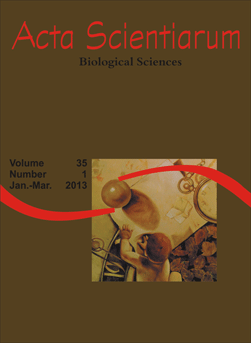<b>Testis evaluation of adult Wistar rats after neonatal treatment with fluoxetine</b> - doi: 10.4025/actascibiolsci.v35i1.10946
Abstract
In current assay the serotoninergic system in newly-born Wistar rats underwent pharmacological modification by fluoxetine, a selective serotonin reuptake inhibitor (SSRI), to investigate its repercussion on testicular parameters in adult animals. Thirty animals were distributed according to treatment: control animals (n = 6), animals treated with 1 mg kg-1 (n = 6), 5 mg kg-1 (n = 6), 10 mg kg-1 (n = 6) and 20 mg kg-1 (n = 6) of fluoxetine (IP). When 150 days old, the animals were anesthetized and perfused intra-cardiacally with fixative solution. Testes were routinely processed for inclusion in plastic resin (methacrylate glycol). Further, 4 µm-thick histological sections were stained with toluidine blue/sodium borate 1% and analyzed histometrically. Pharmacological intervention on the serotoninergic system during the postnatal period of the testes development in Wistar rats with fluoxetine chlorohydrate reduced parameters, such as testicular weight, testis liquid weight and seminiferous tubules diameter. However, testicular parameters, such as daily sperm production (DSP), spermatogenesis efficiency (DSP/g/testis) and cell population in stage VII of adult animals, were not influenced by fluoxetine chlorohydrate usage during neonatal period. Results show that administration of fluoxetine during 21 days after birth may induce adverse changes in the spermatogenesis of adult rats.
Downloads
DECLARATION OF ORIGINALITY AND COPYRIGHTS
I Declare that current article is original and has not been submitted for publication, in part or in whole, to any other national or international journal.
The copyrights belong exclusively to the authors. Published content is licensed under Creative Commons Attribution 4.0 (CC BY 4.0) guidelines, which allows sharing (copy and distribution of the material in any medium or format) and adaptation (remix, transform, and build upon the material) for any purpose, even commercially, under the terms of attribution.
Read this link for further information on how to use CC BY 4.0 properly.












1.png)




3.png)













